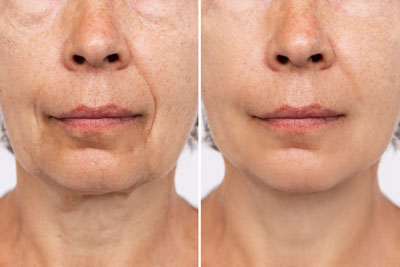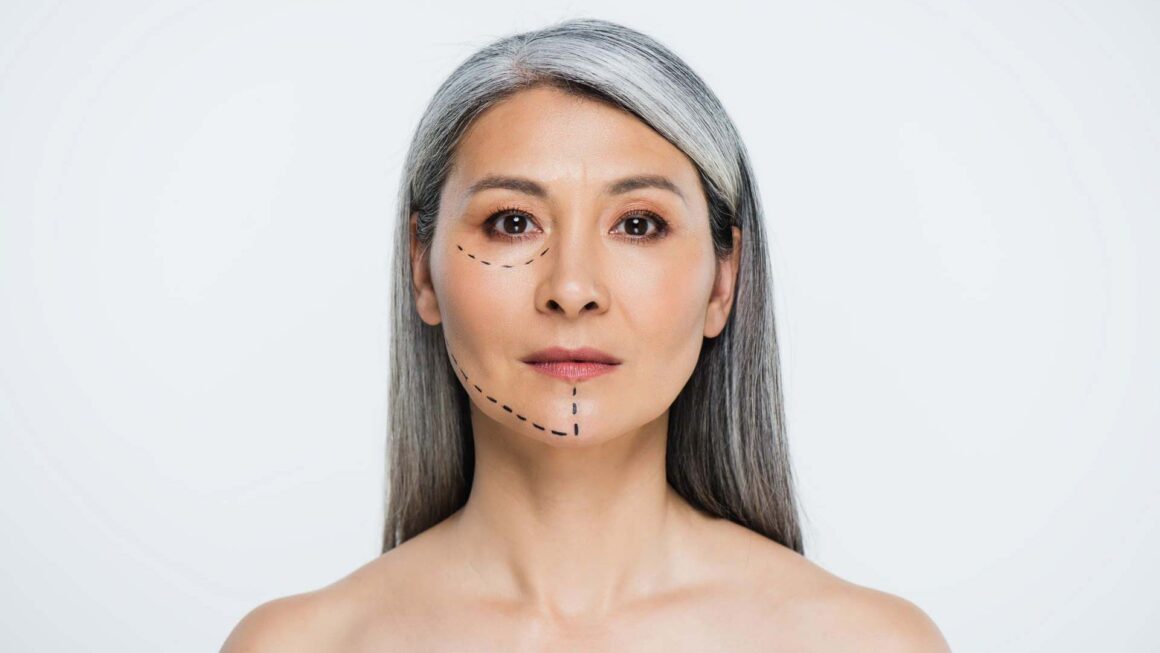Due to genetic factors and aging, sagging and wrinkles form on the face. Facelift surgery is a type of cosmetic surgery applied against sagging and wrinkles in order to give facial features a younger and natural look.
 Facelift surgery cannot stop aging; however, a longterm youthful appearance in the face is achieved. With facelift surgery, the sagging skin on the forehead, face and neck; as well as excess adipose tissue on the cheek and neck are removed, the sheaths of the facial muscles and adipose tissues are pulled to their anatomical places and facial tissues are reinforced.
Facelift surgery cannot stop aging; however, a longterm youthful appearance in the face is achieved. With facelift surgery, the sagging skin on the forehead, face and neck; as well as excess adipose tissue on the cheek and neck are removed, the sheaths of the facial muscles and adipose tissues are pulled to their anatomical places and facial tissues are reinforced.
Facelift operations are practiced on men and women over the age of 40, when cosmetic products and procedures such as botox and fillings are insufficient. Its ideal application is on people whose face and neck skin has started to sag, but whose skin has not yet lost its elasticity, and who have no other health problems. Even though there is no age limit for facelift surgery, as long as there are no health problems, it is mostly performed on middle aged and older people. Full or limited facelift surgery is also possible at an earlier age in people with sagging and wrinkles on their faces due to genetic or physical factors such as, smoking, consumption of alcohol or heavy stress.
For people with excessive sagging and wrinkles on their face, the ‘Classic Facelift Surgery’ is recommended. In the classic facelift surgery, a small incision is made starting from the front of the person’s ear extending to the back of the ear. The crucial step of this technique is that the deep tissues are stretched. The stretching of the deep tissues along with the skin is essential for the success and long-term effectiveness of this surgery. The same process is applied to the neck, providing a tension towards the chin. During facelift surgery, additional surgeries (such as nose, eyelid or ear procedures, forehead correction) or other aesthetic applications (such as filling, peeling) can be added to provide a younger and more aesthetic appearance to the face.
There are three types of classic facelift surgery:
• ‘ Mini Facelift’ surgery is preferred for patients whose facial skin does not yet show much sagging, when gravity and collagen loss in the cheek area of the face has caused slight sagging in the cheeks. The surgery aims to lift the sagging cheek area without going too far into the deep tissues. Loose tissue is removed from the front of the ear, the inner tissues are tightened.
Mini Facelift’ surgery is preferred for patients whose facial skin does not yet show much sagging, when gravity and collagen loss in the cheek area of the face has caused slight sagging in the cheeks. The surgery aims to lift the sagging cheek area without going too far into the deep tissues. Loose tissue is removed from the front of the ear, the inner tissues are tightened.
• ‘Midfacelift’ (Cheek) surgery is usually performed on people with sagging in the cheek area under the eyes. With the incision made under the eye, the sagging cheek tissue is lifted.
• ‘Full Facelift’ surgery is preferred for older skin types. With this surgery, the entire cheek area, jaw line and neck are stretched with an incision starting from the scalp area of the temple, continuing to the front of the ear and ending behind the ear.
Another method used for facelifting is ‘Endoscopic Facelift’ surgery. It is a method generally used for middle-aged people with less wrinkles, sagging and deformations on their faces. This surgery is done with 4 mm thick cameras. In this technique, small incisions are made in the scalp. Using the endoscope, the deep tissues of the upper and middle face are pulled, lifted and hung up. If necessary, an additional incision can be made through the mouth. In this way, deeper tissues are pulled and stretched. The significant advantages of this method are that there is no incision from the outside and the results are long-lasting.
Frequently Asked Questions
The reasons for facial aging are as follows:
- Advanced age
- Genetic factors
- Exposure to damaging sunrays
- Air pollution
- Unhealthy diet
- Alcohol and tobacco consumption
- Wrong usage and application of cosmetic products
- Stress
The face area is exposed to the sun and air pollution al the time. Therefore, it shows signs of aging much faster than other parts of the body.
The signs of aging in the facial area follow a process that appears from top to bottom. The signs of aging on the face are, clear appearance of forehead lines, drooping of eyebrows and eyelids, lines and bags around and under the eyes, deep lines in the mouth-nose area, sagging on the cheek, loss of the chin contour, oiliness on the neck and formation of skin curtains. In general, the skin loses its elasticity and vitality, it becomes thinner, wrinkles and sagging appear, sunspots and other moles on the skin become more evident.
Although the surgery is often applied to women and men over the age of 40, anyone who is bothered by sagging and wrinkles on their face can have facelift surgery.
Facelift surgery is applied to people whose face and neck skin has started to sag, but whose skin has not yet lost its elasticity, and who have no other health problems. Often, men and women over the age of 40 apply for this surgery. However, sometimes due to genetic reasons, facial sagging may occur at an early age. Therefore, the primary factor in the development of facial deformities is not age, but the speed and degree of aging.
Yes. Although general anesthesia is most frequently used for facelift depending on the type of the surgery, some applications can be performed with sedation and local anesthesia.
There are two types of facelift surgery: the classic facelift surgery and the endoscopic facelift surgery. Your surgeon will decide on the technique best suited for you after physical examination, according to the degree of sagging, loosening and wrinkles on your face. The classic facelift is preferred for people with a high degree of skin wrinkles and sagging. In this technique, facial tissue is separated from the main tissue, starting from the hairline. Success in this surgery is achieved by the stretching of the tissues under the skin, not the skin itself. Endoscopic facelift surgery is suitable for people who have sagging in the forehead and mid-face area, but have no dermatological problems and whose skin has not lost its elasticity yet. In the endoscopic technique, the tissues are suspended by stretching them upwards through tiny incisions with the usage of 3-4 mm thick instruments and cameras.
As in every surgical operation, bleeding, infection, collection of blood or fluid under the skin, and wound dehiscence may occur during or after facelift surgery. Also, rare temporary facial numbing may be seen.
As in all types of surgeries, you should quit smoking and stop taking aspirin 3 weeks before the facelift surgery. During the last 10 days, blood thinners medications like aspirin, painkillers, herbal teas, supplements such as vitamin E, fish oil, and multivitamins should not be used.
Mild pain may be felt for a few days. This pain is relieved with drugs. In endoscopic facelift surgery, pain can be felt only in the areas of suspension. In fact, in facelift surgery, the feeling of tension and pressure is more prominent than pain. Again, after all facelift surgeries, especially after endoscopic facelift, you will have some swelling and bruising on your face. You may even experience a loss of sensation in your face. All of this will pass within a month at the most.
There may be general swelling and bruising after the classic facelift surgery. Swelling and bruises will increase considerably in the first week and then will slowly begin to regress. In order to shorten this process, it is recommended to apply ice to the cheeks and to wear a neck brace in the first days. After about 2 weeks, the swelling and bruises will completely disappear. After the endoscopic facelift surgery, there will not be much bruising, but there may be some swelling around the eyes and in the middle part of face for a long period of time. In the first 3 weeks, these swellings are very noticeable. A pressure bandage applied to the forehead after the surgery minimizes this swelling.
You can take a bath with warm water 3 days after the classic facelift surgery. You can wash your face after the bands are removed. You can shower one day after the endoscopic facelift surgery.
Returning to normal life after facelift surgery is quick and easy. Depending on the technique of the facelift surgery, you should return to your normal life within 7-10 days. However, after returning to your routine lifestyle, heavy exercise should be avoided for some time.
You can return to work 7-10 days after the classic facelift and 1 week after the endoscopic facelift surgery.
After classic facelift surgery, you can start walking as exercise 2 weeks later, and doing heavy sports 6 weeks later. After endoscopic facelift surgery, you can start walking as exercise one week later, and doing heavy sports 4-6 weeks later according to your physician’s recommendation.
Facelift surgeries will return your face to its state of 10 years ago in the most natural way, and the aging process will continue from there. Your face will look as young and dynamic as it was 10 years ago.
After facelift surgery, there may be excessive stretching in facial expressions due to excessive stretching, there may be a confused expression on the face due to excessive hanging of the eyebrows, or even facial asymmetry. Therefore, preoperative planning should be planned out with attention and care.
In classic facelift surgery, scars are not visible since the incisions made behind the ear is in a concealed area. There are no scars after the endoscopic facelift surgery.
It is not obvious from the surgical scars that you have had a facelift surgery. However, thanks to the 10 years younger and more dynamic look your face has gained, the positive change in your face will be noticed.
Only 3 months after both classical and endoscopic facelift surgery, the face regains its normal appearance.
The effectiveness of facelift surgery is 10-15 years on average, depending on the skin structure of the patient and environmental factors.
Facelift surgery is a cosmetic surgery aimed at eliminating visual disturbances that occur as a result of the loosening of skin and muscles on the face caused by aging or genetic reasons. Therefore, as a result, the sagging excess skin is removed and the tissues are given a more tense appearance. Thus, a younger and more dynamic facial appearance is obtained. This, in turn, contributes to an increase in one’s self-confidence and self-love.
It would not be wrong to say ‘Yes, the results are permanent’. The effects of most facelift surgeries last 10-15 years. The duration of the effect may vary according to the genetic characteristics of the person, their lifestyle and environmental factors. Once facelift surgery is performed, its effect cannot be reversed, so its effect is permanent in terms of being irreversible. However, since nothing can completely stop the aging process, you will continue to age in the years after surgery.
Facelift surgery is a surgical method that removes sagging and wrinkles on the face due to genetics and aging by means of stretching and hanging. The main process is to replace the skin which is hanging downwards. The purpose of these surgeries is not only to stretch the face, but also to shape the face. The same procedure is applied to the neck, providing a tension towards the chin. Thus, it is ensured that facial features appear younger for a longer period of time.
The advantages of endoscopic facelift surgery are:
Its effect is permanent.
No scars remain.
The recovery period is quite short.
Complications after surgery are very few.
Facelift surgeries cannot stop aging. They return your face to its appearance 10 years prior in the most natural way and makes aging continue from this point on. For this reason, if the effects of the surgery diminish in time, there is no problem in getting a second surgery in the upcoming years.


Leave a Reply
You must be logged in to post a comment.